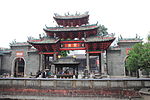Search results
Appearance
There is a page named "Foshan" on Wikipedia
- Foshan is a prefecture-level city in central Guangdong Province, China. The entire prefecture covers 3,848 km2 (1,486 sq mi) and had a population of 9...34 KB (2,094 words) - 06:14, 16 April 2024
- The Foshan Metro (Chinese: 佛山地铁; branded as FMetro) is the rapid transit system of the city of Foshan in Guangdong, China. Guangfo line is operated by...15 KB (790 words) - 04:24, 26 June 2024
- Shunde (Shun Tak in Cantonese) is a district of the city of Foshan, Guangdong province, located in the Pearl River Delta. It had a population of 2,464...20 KB (1,458 words) - 15:35, 14 June 2024
- District (simplified Chinese: 南海区; traditional Chinese: 南海區), is a district of Foshan, Guangdong, China. Its government is the first to have developed e-government...6 KB (355 words) - 17:58, 25 March 2024
- Guangzhou Loong Lions (redirect from Foshan Kylins)Dragons. In 2010, the Shaanxi Kylins moved from Xi'an to Foshan, and renamed themselves the Foshan Dralions. The club opted to start rendering its English...8 KB (329 words) - 21:06, 14 June 2024
- Ip Man (category People from Foshan)Shui (吳瑞) as the third of four children. He grew up in a wealthy family in Foshan (Fatshan), Guangdong (Kwangtung), and received traditional Chinese education...30 KB (3,484 words) - 09:18, 18 June 2024
- Foshan Shadi Airport (IATA: FUO, ICAO: ZGFS), or Shadi Air Base, is a dual-use military and public airport serving the city of Foshan in South Central...8 KB (383 words) - 04:20, 26 June 2024
- Foshan Nanshi Football Club (simplified Chinese: 佛山南狮足球俱乐部; traditional Chinese: 佛山南獅足球俱樂部; pinyin: Fóshān Nánshī Zúqiú Jùlèbù; lit. 'Foshan Southern Lions...6 KB (318 words) - 14:42, 30 June 2024
- Foshan University (FOSU, Chinese: 佛山大学) is a designated full-time comprehensive university in Foshan, Guangdong province, China. The university is a merger...4 KB (283 words) - 04:19, 26 June 2024
- (Chinese: 狮山镇) is a town in Nanhai District, Foshan, Guangdong, China. Shishan railway station Wikimedia Commons has media related to Shishan, Foshan. v t e...488 bytes (47 words) - 21:48, 21 May 2022
- Gaoming is an urban district of Foshan, Guangdong, China. Gaoming is located west of downtown Foshan and had a population of 420,044 during the 2010 census...7 KB (631 words) - 23:06, 12 June 2024
- The Foshan Open is a golf tournament on the Challenge Tour. It was played for the first time in October 2013 at the Foshan Golf Club in Foshan, China....4 KB (132 words) - 10:24, 29 August 2023
- Beijiao, Guangdong (redirect from Beijiao, Foshan)Zhèn) is a town in the district of Shunde, in the prefecture-level city of Foshan, Guangdong, China. The town covers an area of 92.11 square kilometres (35...7 KB (478 words) - 05:44, 27 September 2023
- Line 2 of Foshan Metro (FMetro) (Chinese: 佛山地铁2号线; pinyin: Fóshān Dìtiě Èr Hào Xiàn) is a metro line in Foshan. It runs in a south-west direction, connecting...5 KB (84 words) - 07:17, 1 May 2024
- Foshan Hubei Wugang B v Foshan Foshan v Tianjin B Foshan v Henan Jianye Guangxi Huahai v Foshan Guangzhou B v Foshan Foshan v Qingdao Hainiu Foshan v...12 KB (151 words) - 22:24, 11 January 2024
- intercity railway or Foshan–Zhaoqing intercity railway, is a regional railway within Guangdong province, China. It connects between Foshan and Zhaoqing, with...20 KB (1,026 words) - 21:26, 13 June 2024
- Lishui, Guangdong (redirect from Lishui, Foshan)2011; 113.1588 Lishui Town (Chinese: 里水镇) is a town in Nanhai District, Foshan, Guangdong, China. It covers an area of 148.28 square kilometres (57.25 sq mi)...871 bytes (77 words) - 21:46, 21 May 2022
- Chancheng District is a district and the seat of the city of Foshan, Guangdong Province, China. Chancheng is the economic, cultural and political center...9 KB (784 words) - 18:01, 25 March 2024
- 113.116307°E / 23.035151; 113.116307 Foshan Ancestral Temple aka. Foshan Zumiao is a Daoist temple in Foshan, Guangdong, China. It is a national AAAA...4 KB (442 words) - 09:47, 14 April 2024
- Line 3 of Foshan Metro (FMetro) (Chinese: 佛山地铁3号线; pinyin: Fóshān Dìtiě Sān Hào Xiàn) is a metro line in Foshan that runs 40.72 km (25.30 mi) between...8 KB (124 words) - 23:47, 8 June 2024
- See also: Fóshān and Fo-shan English Wikipedia has an article on: Foshan Wikipedia Wikimedia Commons has more media related to: Foshan Fo-shan (from French
- Foshan (佛山 Fahtsāan in Cantonese, Fóshān in Mandarin) is an industrial city in Guangdong. Though it has about seven million people, it is relatively little
- months. From July 28 onwards, residents of four Guangdong cities (Dongguan, Foshan, Jiangmen and Zhongshan) can apply to visit Hong Kong in their individual
- The incidences are even higher, especially in the regions of Zhaoqing, Foshan and Guangzhou in the central and western part of Guangdong province. According













